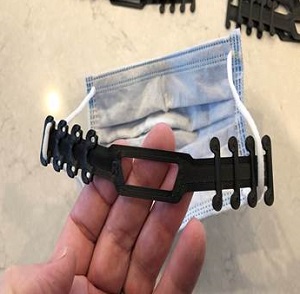Protecting the Frontlines
Golden Valley, Minnesota is 1,583 miles from Moffitt Cancer Center’s Magnolia campus. Despite the distance, Norston Fontaine knew he could help health care workers in Tampa through the COVID-19 pandemic.
Fontaine is the owner of STACKER, a 3D printer manufacturing company in the Midwest. He also has a personal connection to Moffitt. His stepson Casey Liveringhouse works with the internal and hospital medicine program and will begin his residency in radiation oncology at the cancer center in July.
“My wife Lisa follows Moffitt on Facebook. That's how we learned about the need for face masks,” said Fontaine. “We’ve been printing lots of face shields and surgical mask straps, both of which we were happy to donate to the organization.”

3D printed mask straps can offer relief to health care workers because it keeps the straps off their ears.
Fontaine shipped 50 face shields and mask straps to Moffitt and plans to donate at least a hundred more of each. The personal protective equipment will help keep frontline staff safe from exposure to the Coronavirus.
“The designs for the face shields and mask straps we printed have been vetted by many in the health care industry,” said Fontaine. “The 3D printing community has been quick to help provide all sorts of solutions for the COVID-19 crisis.”
So how exactly do 3D printers work? Fontaine compares it to a hot glue gun. It starts out with a model created by specialists, digital artists and engineers. The model is loaded into the printer's software and converted into a format that can be read by the printer. The printer then takes the data and builds the model, layer by layer, using spools of plastic filament as the raw material. The filament is fed into a hot end which causes it to melt and take the shape of the model.

The 3D printed mask straps offer different hook options for a secure fit
“Just about everything is or can be 3D printed. Things like casting patterns, face shield frames, medical prosthetics, replacement parts, jigs, fixtures and other manufacturing aids,” said Fontaine. “The advantage of 3D printed parts is that they can be easily customized and printed on demand when you need them.”
Although Fontaine has never walked the halls at Moffitt, he appreciates the commitment by health care workers, like his stepson, to the community, especially during these trying times.
“My wife and I have been to Tampa many times and always enjoy our time there,” said Fontaine. “We’ve driven by Moffitt Cancer Center and know exactly where it is. We look forward to visiting once it's safe to travel again, hopefully soon.”
As for his stepson Dr. Liveringhouse, he believes the 3D shields will help bring some comfort to his colleagues.
"I think a lot of health care workers worry that we will catch the virus but be asymptomatic, causing us to unknowingly transmit it to others who may be more at risk," said Liveringhouse. "Wearing a mask or face shield gives us a little bit of peace of mind, knowing it might help to decrease the risk of that transmission from happening."



